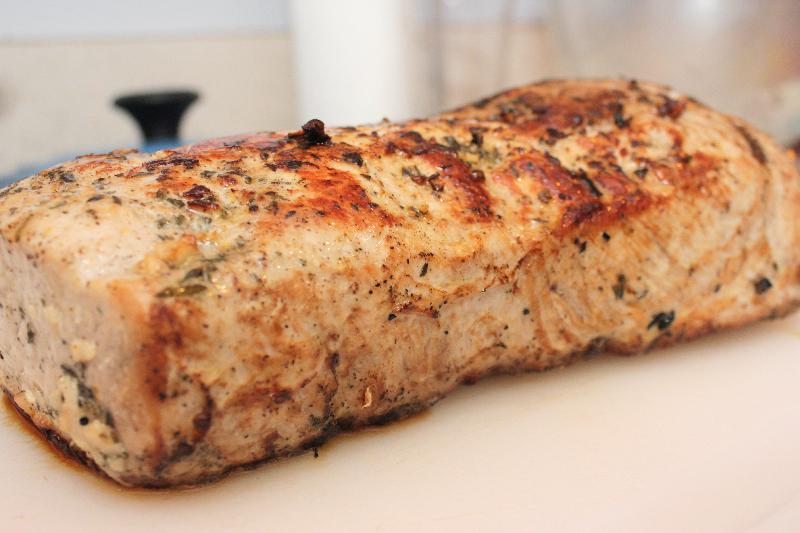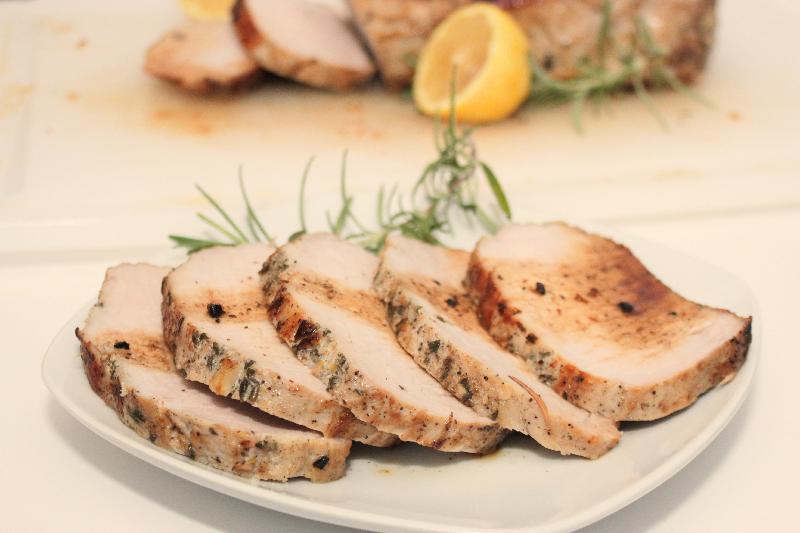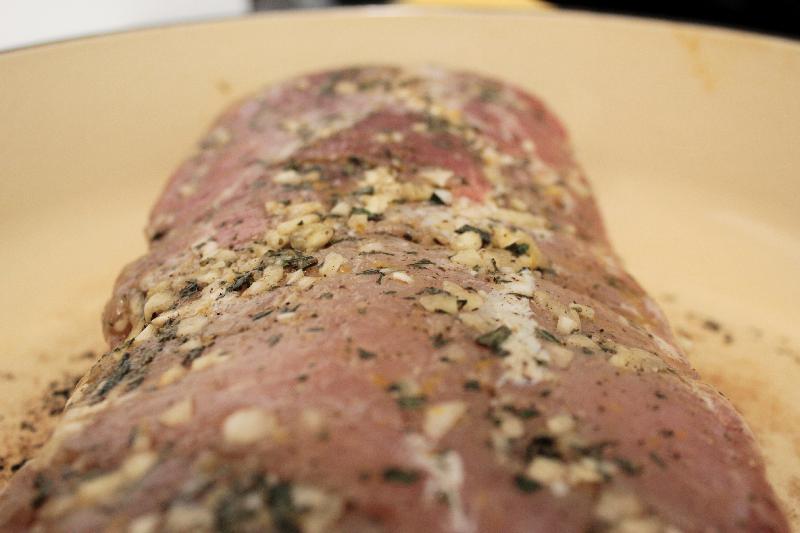This rosemary garlic pork recipe is lovely. Topped with balsamic reduction, it’s killer. Showy and versatile, it makes enough for a crowd, or for a week’s worth of leftovers!
[[This post contains Amazon affiliate links. If you click on one of the links and then purchase something through Amazon, Bear & Bug Eats gets a tiny commission!]]
One of the benefits of being married to someone who is a) a brilliant cook and b) has a very different approach to food is that I can learn a lot from him. Robby cooked a really fabulous pork loin a while back, and I instantly resolved to learn to do the same. You are the beneficiaries of the experimenting that followed (but without having to eat the couple that came out dry).
This is a recipe that I like a lot for its flexibility. It calls for an overnight marinade; but that can be skipped if you’re short on time. It calls for a sear; but that can be skipped if you don’t feel like standing over the stove. And it can be done with a huge 4-pound pork loin, which is what I found at Lucky’s Market, or with the pair of smaller pork loins that usually come in a package.
Rosemary Garlic Pork Loin Tips
If you have time, I highly recommend letting your pork marinate for at least 8 hours. I usually prep mine night before (and if I remember, I’ll turn the pork in the fridge once the next day to help keep the meat moist throughout). The benefit of doing this is that when you come around to cooking, the prep is done! You can throw some green beans in a pan or make mashed potatoes without worrying about the entree.
You can, if you must, also skip the searing step. I like this part because it doesn’t take very long but does create a really lovely brown flavorful crust, which I adore. But if you’re pressed for time or don’t have an oven-appropriate dish that can also go on the stove, feel free to skip this part.
 The cook time listed is deliberately vague, because it depends hugely on the size of your tenderloin/s. The best tip is to use an instant-read thermometer (here’s a nice variety on Amazon) to find when the middle is at 150F. At that point, remove it from the oven and let it rest in the pan, where it will continue cooking for a few minutes. Don’t worry that it will end up undercooked; you’d be surprised at how much the temperature continues to rise even after it’s out of the oven. I like to leave the thermometer in the meat just to watch it, which is sort of nerdy but there you are.
The cook time listed is deliberately vague, because it depends hugely on the size of your tenderloin/s. The best tip is to use an instant-read thermometer (here’s a nice variety on Amazon) to find when the middle is at 150F. At that point, remove it from the oven and let it rest in the pan, where it will continue cooking for a few minutes. Don’t worry that it will end up undercooked; you’d be surprised at how much the temperature continues to rise even after it’s out of the oven. I like to leave the thermometer in the meat just to watch it, which is sort of nerdy but there you are.
This goes great with mashed potatoes or roasted veggies. It will almost certainly make leftovers. We’ve reheated slices in barbecue sauce (sans balsamic), and we’ve shredded some for sandwiches/quesadillas/mac’n’cheese topping. And I’m dead certain that this could be made with pork chops, or even with chicken or turkey. In other words: one recipe, many meals. My kind of cooking.
Pork can go with almost anything. It’s more substantial than chicken or fish, but not as heavy as beef; so you can go anywhere from a medium-bodied white to a medium-bodied red. Here are some recommendations that also will not clash with the balsamic reduction.
Sur lie-aged pinot gris: “Lees” are leftover yeast particles from the fermentation process. When these are left in the cask longer, they produce a sort of creaminess not unlike that found in oaky Chardonnay, but without the oak flavor. One of Robby’s favorites, and which is increasingly available, is King Estate Domaine Pinot Gris, usually about $22 (sometimes comes in half bottles!).
Blanco de tempranillo: White wine made from red tempranillo grapes. Try Pago del Vicario, which has a lot of fruit: cherry and strawberry notes, pear and apple, with some acidity. It’s usually around $15-20.
Grand Cru Beaujolais: “Cru” is an area, and “grand cru” is a level of classification that indicates that a given area has a strong wine reputation. Beaujolais has a fabulous value: grand cru wines often sell in the hundreds to thousands of dollars, but beaujolais usually sells for $25-40, and rarely over $40. They tend to be on the light side of red with some acidity, and notes a bit like berry pie. Robby likes ones from the Morgon cru, which reminds him of dark berry cobbler and vanilla ice cream.
Côtes du Rhône granache: Paler but medium to full-bodied, with notes that often remind people of fruit roll-ups and cinnamon; sometimes with relatively high amounts of alcohol. Granache is grown in a number of places, but Côtes du Rhône ones are the easiest to drink.
Adapted from Kevin Is Cooking.
PrintPerfect Pork Loin
- Prep Time: 10 minutes
- Cook Time: 35 minutes
- Total Time: 45 minutes
- Yield: 8 servings 1x
Ingredients
- 3–4 pound pork tenderloin, or 2 smaller ones, with any big chunks of fat removed
- 6 cloves of garlic, chopped
- 1/4 cup chopped fresh rosemary
- 2 tablespoons lemon zest, chopped
- 2 tablespoons olive oil
- 1 tablespoon salt
- 1 teaspoon ground black pepper
- 1 cup beef stock
- 1 cup balsamic vinegar
- 2 tablespoons butter
- Optional: 2 tbsp capers
Instructions
- The night before, combine rosemary, lemon zest, garlic, and olive oil into a rough paste.
- Sprinkle or rub salt and pepper into pork, followed by garlic paste. Wrap pork in plastic wrap and refrigerate. Turn once or twice.
- When ready to cook, remove pork from fridge. Preheat oven to 400F.
- Heat a little oil in a large, ovenproof skillet over medium high heat. Sear pork until nice and brown on all sides, 5-10 minutes.
- Slide pan into oven. Roast until pork’s internal temperature is 150F, 25-40 minutes depending on the size. Remove from oven.
- Allow pork to rest in pan for 5 minutes, then move to a cutting board. Place the pan on the stove over medium high heat. Add beef broth and balsamic vinegar and bring to a boil, scraping the stuck bits from the bottom.
- Turn heat to low and simmer until sauce is reduced by half, about 5 minutes. Turn off heat and stir in butter and capers, if using.
- Slice pork, drizzle with sauce, and serve.
Notes
Marinating the pork overnight gives the most flavor, but it can be skipped if necessary. If you want even more garlic, use a knife to poke a few slits into the pork and stuff whole garlic cloves into the slits.







